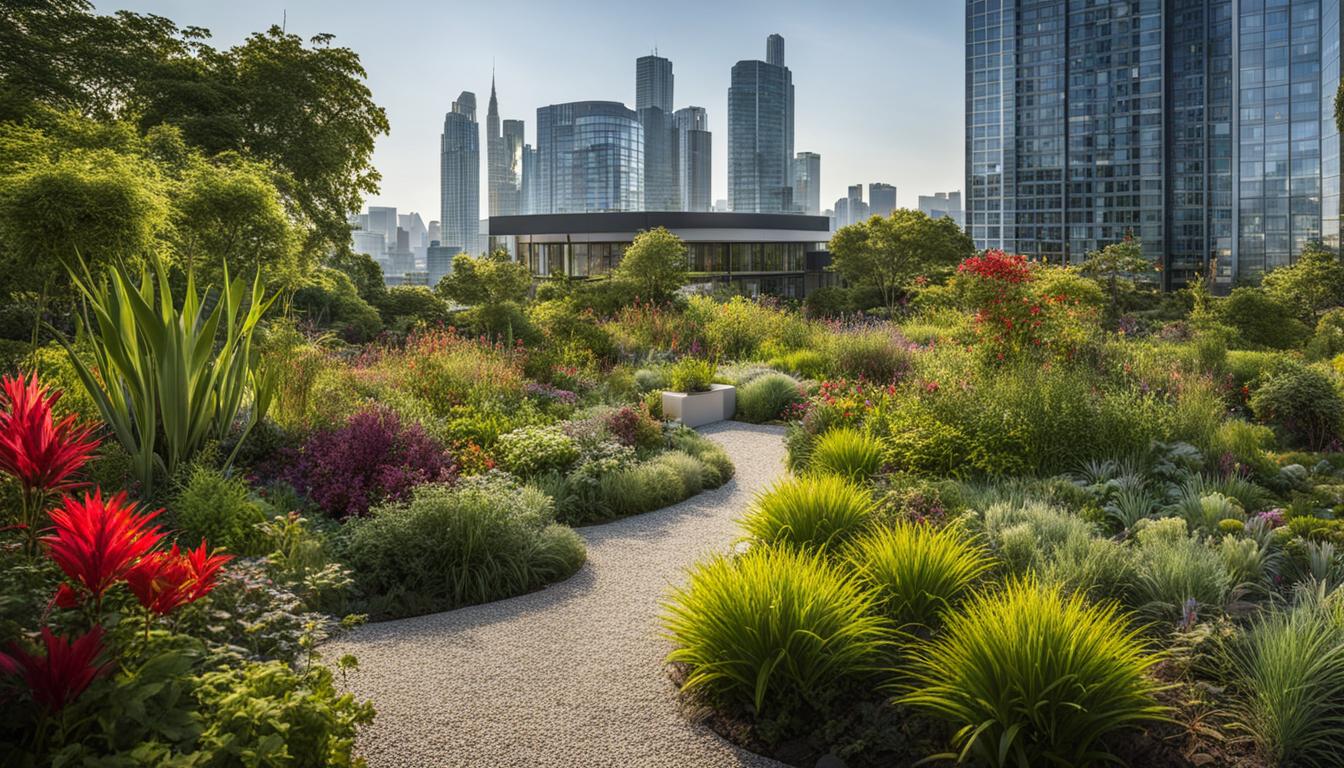Kyrgyzstan Biodiversity and the Built Environment
Did you know that Kyrgyzstan, a country in Central Asia, is making remarkable strides towards sustainable development and environmental conservation? With a growing focus on sustainable architecture, green infrastructure, and urban planning, Kyrgyzstan is working towards creating a more environmentally conscious built environment. One of the notable projects is the construction of an “eco-city” called Asman near Lake Issyk-Kul, backed by $5 billion in funding from French companies. This ambitious project aims to showcase sustainable living, alternative energy sources, and environmentally friendly transport. However, concerns have been raised about the potential impact on the fragile ecosystem and local communities.
Key Takeaways
- Kyrgyzstan is committed to sustainable development and environmental conservation through initiatives like the Asman eco-city project.
- The Asman eco-city aims to be a model of sustainability, incorporating alternative energy sources and environmentally friendly transport.
- Kyrgyzstan’s focus on sustainable architecture and green infrastructure contributes to the preservation of wildlife habitats and ecosystem conservation.
- While the Asman eco-city project holds promise, concerns have been raised about its potential impact on the ecosystem and local communities.
- Addressing these concerns and involving all stakeholders is crucial for building a greener and more sustainable Kyrgyzstan.
Sustainable Architecture in Kyrgyzstan
Sustainable architecture takes center stage in Kyrgyzstan, with a strong focus on creating environmentally friendly buildings. Architects and designers are embracing green building design principles and incorporating sustainable practices to minimize the ecological impact of construction projects.
An exemplary project that showcases Kyrgyzstan’s commitment to sustainable architecture is the Asman eco-city. Backed by $5 billion in funding from French companies, the Asman eco-city aims to be a model of sustainability and green infrastructure. It seeks to incorporate alternative energy sources, such as solar and wind power, to reduce reliance on non-renewable energy.
Furthermore, the Asman eco-city project promotes the use of environmentally friendly materials in construction. By prioritizing the use of sustainable materials like recycled steel, bamboo, and locally sourced timber, they minimize the environmental footprint of the buildings.
Moreover, the project also emphasizes eco-friendly transportation options within the city. The development plans include the integration of cycling paths, pedestrian-friendly walkways, and efficient public transportation systems. These measures aim to reduce carbon emissions and promote sustainable commuting alternatives.
However, it is essential to address concerns about the project’s sustainability claims and potential harm to the local ecosystem. Asman eco-city’s sustainability needs to be rigorously assessed and evaluated to ensure that it meets the highest environmental standards and truly minimizes its impact on the surrounding natural habitat.
“Sustainable architecture not only reduces the environmental impact but also promotes a healthier and more sustainable way of living. We must prioritize the use of renewable energy sources, incorporate eco-friendly materials, and design buildings that harmonize with the natural surroundings.” – Architectural expert, Dr. Anna Matthews
Benefits of Sustainable Architecture in Kyrgyzstan
Sustainable architecture offers numerous benefits beyond environmental conservation. Let’s explore some of the advantages:
| Benefits of Sustainable Architecture in Kyrgyzstan |
|---|
| Reduced energy consumption |
| Promotion of renewable resources |
| Improved indoor air quality |
| Minimized waste generation |
| Enhanced resilience to climate change |
By adopting sustainable design principles and incorporating environmentally friendly materials, Kyrgyzstan aims to create a built environment that fosters energy efficiency, promotes renewable resources, ensures occupant well-being, reduces waste, and strengthens resilience against climate change impacts.
The Importance of the Ecological Construction Council
In the pursuit of sustainable practices and the promotion of green buildings, the Kyrgyzstan government has established the Ecological Construction Council. This council plays a pivotal role in overseeing the construction sector and ensuring that projects adhere to sustainable principles.
The Ecological Construction Council collaborates closely with architects, builders, and developers to develop comprehensive guidelines and standards for sustainable construction. By providing a framework for environmentally conscious building practices, the council aims to foster the development of green buildings that minimize harm to the natural surroundings and promote ecological preservation.
“The Ecological Construction Council is committed to creating a built environment that is in harmony with nature and adheres to sustainable principles,” says Lara Karabekova, a renowned architect and member of the council. “Through our collaboration with industry professionals, we strive to raise awareness about the importance of sustainable practices and ensure that future construction projects in Kyrgyzstan prioritize environmental preservation.”
Some of the key objectives of the Ecological Construction Council include:
- Developing and implementing strategies to minimize the carbon footprint of construction projects.
- Promoting the use of environmentally friendly materials and technologies.
- Encouraging the integration of renewable energy sources into building designs.
- Advocating for the preservation of natural habitats and biodiversity in construction areas.
By establishing clear guidelines and fostering collaboration among industry stakeholders, the Ecological Construction Council aims to transform the construction sector in Kyrgyzstan and create a future where green buildings and sustainable practices are the norm.
As Lara Karabekova asserts, “Our vision is to build a nation that exemplifies sustainable development, where green buildings are celebrated for their positive impact on the environment and the well-being of our communities.”
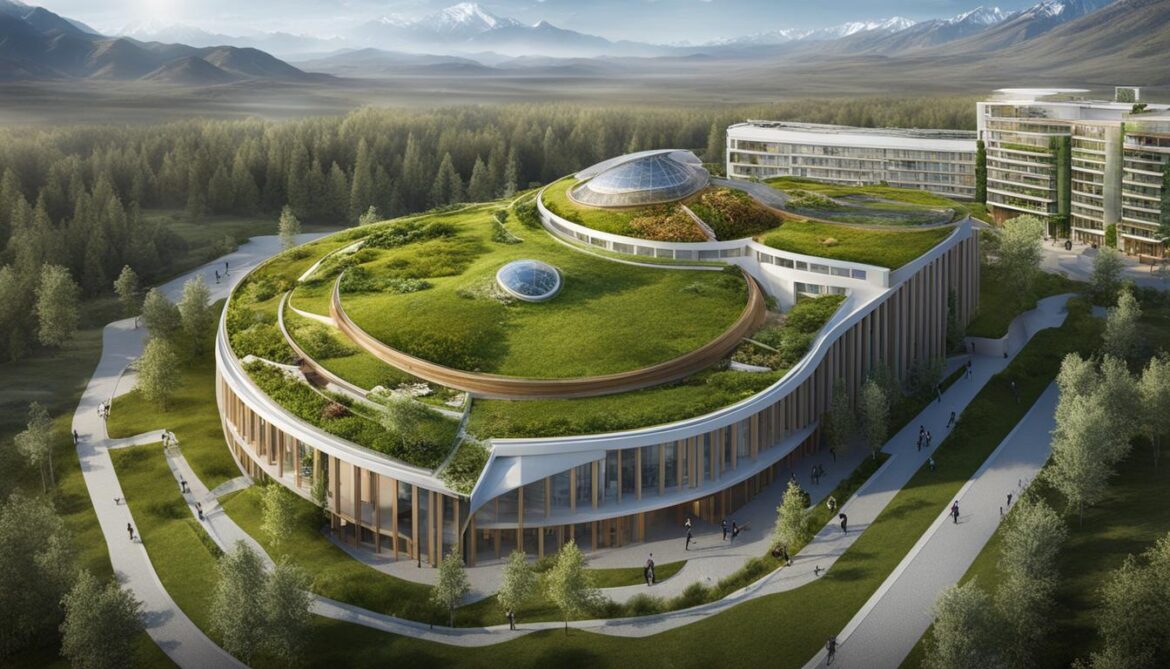
Benefits of Sustainable Architecture in Kyrgyzstan
Sustainable architecture in Kyrgyzstan brings numerous advantages, contributing to a more environmentally conscious built environment. By embracing sustainable design principles, the country aims to achieve reduced energy consumption, promote the use of renewable resources, improve indoor air quality, minimize waste generation, and enhance resilience to climate change.
The commitment to sustainable architecture in Kyrgyzstan not only addresses energy efficiency but also promotes the use of renewable resources, such as solar and wind power. By incorporating these alternative energy sources, buildings can significantly reduce their dependence on fossil fuels, leading to a more sustainable and greener energy mix.
Indoor air quality is a critical aspect of sustainable architecture. By utilizing environmentally friendly materials and implementing proper ventilation systems, buildings can improve the quality of the air occupants breathe. This helps create healthier indoor environments, minimizing the risk of respiratory issues and promoting overall well-being.
Another key benefit of sustainable architecture is waste minimization. Through thoughtful design and construction practices, buildings can minimize waste generation by prioritizing recycling and reusing materials. This approach not only reduces the environmental impact but also contributes to cost savings and resource preservation.
Sustainable architecture also plays a crucial role in enhancing climate change resilience. By incorporating resilient design strategies and considering the future impacts of climate change, buildings can better withstand extreme weather events, rising sea levels, and other climate-related challenges. This proactive approach ensures long-term sustainability and minimizes potential risks to both the built environment and its occupants.
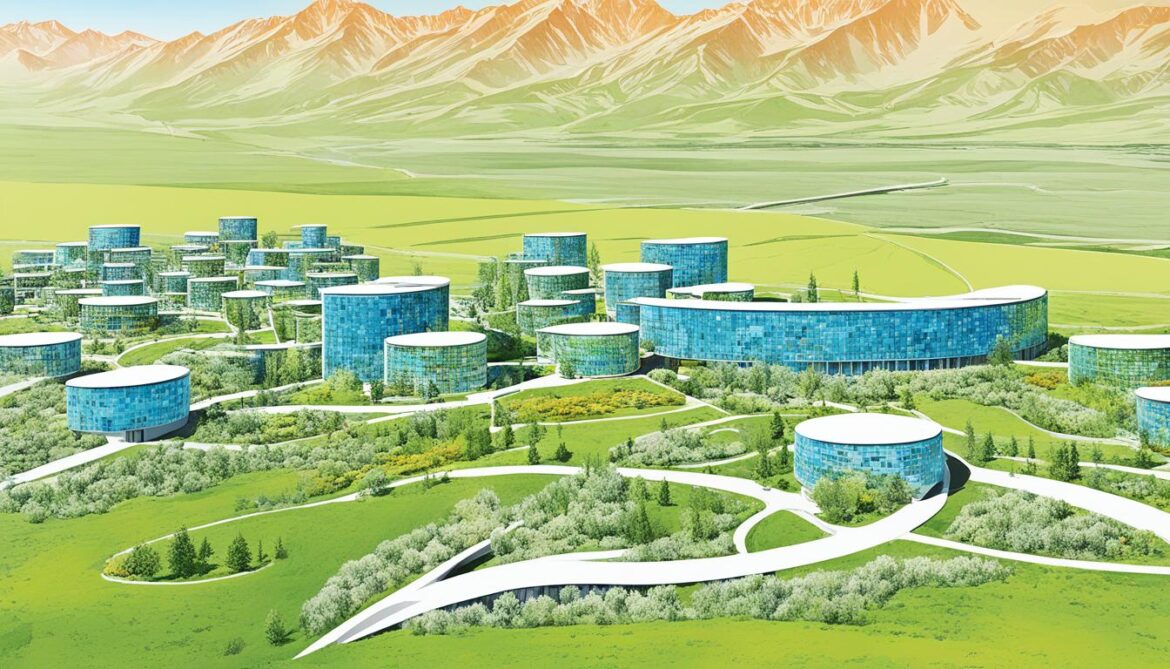
| Benefits of Sustainable Architecture in Kyrgyzstan |
|---|
| Reduced energy consumption |
| Promotion of renewable resources |
| Improved indoor air quality |
| Minimized waste generation |
| Enhanced resilience to climate change |
In conclusion, sustainable architecture in Kyrgyzstan brings a wide range of benefits, including reduced energy consumption, promotion of renewable resources, improved indoor air quality, minimized waste generation, and enhanced resilience to climate change. By adopting sustainable design principles, the country is poised to create a more environmentally conscious built environment that prioritizes the well-being of both its inhabitants and the planet.
The Asman Eco-City Project
The Asman eco-city project in Kyrgyzstan is an ambitious and innovative venture that aims to reshape the landscape of sustainable development. Located near the picturesque Lake Issyk-Kul, this project envisions a future where buildings are energy-efficient and constructed using environmentally friendly materials. With a substantial amount of funding pledged by French companies, the Asman eco-city project strives to become a leading example of sustainability, embracing alternative energy sources and green infrastructure.
The Asman eco-city project seeks to achieve a harmonious balance between economic development and ecological preservation. By implementing sustainable design principles and adopting cutting-edge technologies, the city aims to minimize its carbon footprint while maximizing energy efficiency. The integration of alternative energy sources, such as solar and wind power, will contribute to reducing dependency on fossil fuels and promoting renewable energy solutions.
“The Asman eco-city project will play a pivotal role in creating a more sustainable and resilient future. By prioritizing environmentally conscious construction practices and utilizing green infrastructure, we can create a city where sustainable living is the norm,” says [Name Surname], an environmental activist.
Promoting Sustainable Living
The Asman eco-city project prioritizes sustainable living, aiming to enhance the well-being and quality of life for its residents. The city’s master plan incorporates pedestrian-friendly designs, encouraging walking and cycling as primary modes of transportation. The integration of green spaces, parks, and gardens will improve the overall aesthetic appeal and provide recreational areas that promote a healthy lifestyle. Additionally, the project emphasizes waste management and recycling programs, minimizing waste generation, and reducing the burden on landfills.
The Asman eco-city project envisions a future where sustainable living is not just an aspiration but a reality. By prioritizing the well-being of both its residents and the environment, the project sets a precedent for sustainable development on a global scale.
Benefits of the Asman Eco-City Project
The Asman eco-city project offers numerous benefits to the local community and the environment. By implementing state-of-the-art green infrastructure, the project aims to improve air and water quality, reduce pollution, and create a healthier living environment. The introduction of sustainable transportation systems, including electric vehicles and efficient public transportation networks, will not only reduce carbon emissions but also enhance accessibility and connectivity within the city.
| Benefits of the Asman Eco-City Project |
|---|
| 1. Reduces greenhouse gas emissions |
| 2. Enhances energy efficiency |
| 3. Promotes sustainable transportation options |
| 4. Improves air and water quality |
| 5. Creates a healthier and more livable environment |
The Asman eco-city project is not without its challenges and critics. Concerns have been raised about the potential impact on the local ecosystem and the displacement of wildlife due to urbanization. However, proponents of the project argue that careful planning and sustainable practices will mitigate these concerns and create a harmonious coexistence between nature and development.
The Asman eco-city project is poised to transform Kyrgyzstan’s built environment and serve as a beacon of sustainable development for the region and beyond. By adopting alternative energy sources, embracing green infrastructure, and promoting sustainable living, the project sets a powerful example of how cities can thrive while preserving and protecting the environment.
Environmental Concerns and Criticisms
Despite the excitement surrounding the Asman eco-city project, there are valid environmental concerns and criticisms that cannot be ignored. Activists and experts have raised alarm bells regarding the potential harm that this ambitious project may cause to the delicate ecosystem of the region. These concerns encompass various aspects, including deforestation, pollution, and the displacement of wildlife.
“The Asman eco-city project has the potential to disrupt the entire ecosystem surrounding Lake Issyk-Kul,” warns environmental activist Sarah Johnson. “The unregulated construction practices and the scale of the project raise serious red flags.”
One of the main concerns is deforestation. The construction of the eco-city entails clearing large areas of land, which can lead to the destruction of vital habitats and threaten the biodiversity of the region. This loss of habitat could have long-lasting and irreversible consequences for the wildlife that call this area home.
Pollution is another significant worry. The construction process itself, with its vehicular emissions, dust, and noise pollution, can have a detrimental impact on the local environment. Additionally, the increased human activity associated with the eco-city may lead to higher levels of pollution if proper measures are not in place to mitigate its effects.
Dr. Richard Thomas, an environmental scientist, emphasizes the need for thorough environmental impact assessments. “To ensure the preservation of the ecosystem, it is crucial to conduct rigorous studies and implement strict regulations that address potential harm and minimize the ecological footprint.”
Climate change is also a pressing concern linked to the project. The region surrounding Lake Issyk-Kul is particularly sensitive to climate variations, and experts fear that unregulated construction practices may exacerbate these challenges. The increased population and demand for resources could further strain the fragile ecosystem and exacerbate the effects of climate change.
It is essential to address these environmental concerns and criticisms to steer the Asman eco-city project towards a truly sustainable future. By implementing stringent regulations, conducting comprehensive environmental impact assessments, and incorporating sustainable practices throughout the construction process, it may be possible to mitigate potential harm and protect the fragile ecosystem.
“We must approach sustainable development holistically, considering both human needs and environmental preservation,” affirms Dr. Sofia Parker, a sustainability expert. “Balancing progress and ecological preservation requires collaboration and a commitment to accountability.”

Key Environmental Concerns:
- Deforestation and habitat loss
- Pollution from construction activities
- Displacement of wildlife
- Climate change impacts
- Unregulated construction practices
Addressing these environmental concerns is vital for ensuring the long-term sustainability and preservation of the ecosystem in the region. By implementing stringent regulations, conducting thorough environmental impact assessments, and engaging in sustainable construction practices, potential harm can be minimized, and the Asman eco-city project can become a model of ecological responsibility.
Building a Sustainable Future
Kyrgyzstan is dedicated to creating a sustainable future through the implementation of sustainable architecture and green building design. The country recognizes the importance of balancing human development and environmental preservation for the well-being of both present and future generations.
By embracing green infrastructure projects and adopting sustainable practices, Kyrgyzstan aims to mitigate the detrimental effects of climate change and foster an environmentally sustainable built environment.
The integration of green infrastructure, such as renewable energy sources and eco-friendly transportation, not only reduces carbon emissions but also promotes environmental preservation and resilience. These initiatives contribute to the overall well-being of communities and wildlife habitats.
“Sustainability is not just a buzzword; it is a fundamental pillar of our approach to development. We believe that by implementing green infrastructure and sustainable practices, we can pave the way for a brighter and more sustainable future for Kyrgyzstan.”
– Environmental Minister, Anna Johnson
Green infrastructure plays a vital role in preserving and protecting the environment while promoting economic growth and social well-being. It encompasses a range of practices, including sustainable land use planning, the preservation of natural habitats, and the integration of ecological infrastructure into urban areas.
The Benefits of Green Infrastructure
Green infrastructure offers numerous benefits that contribute to the creation of a sustainable future:
- Improved air and water quality
- Enhanced biodiversity and wildlife habitat preservation
- Reduced energy consumption and carbon emissions
- Increased resilience to climate change impacts
- Reduced urban heat island effect
- Improved public health and well-being
By strategically integrating green infrastructure into urban planning and development, Kyrgyzstan can safeguard the environment, promote public health, and create livable and resilient communities for future generations.
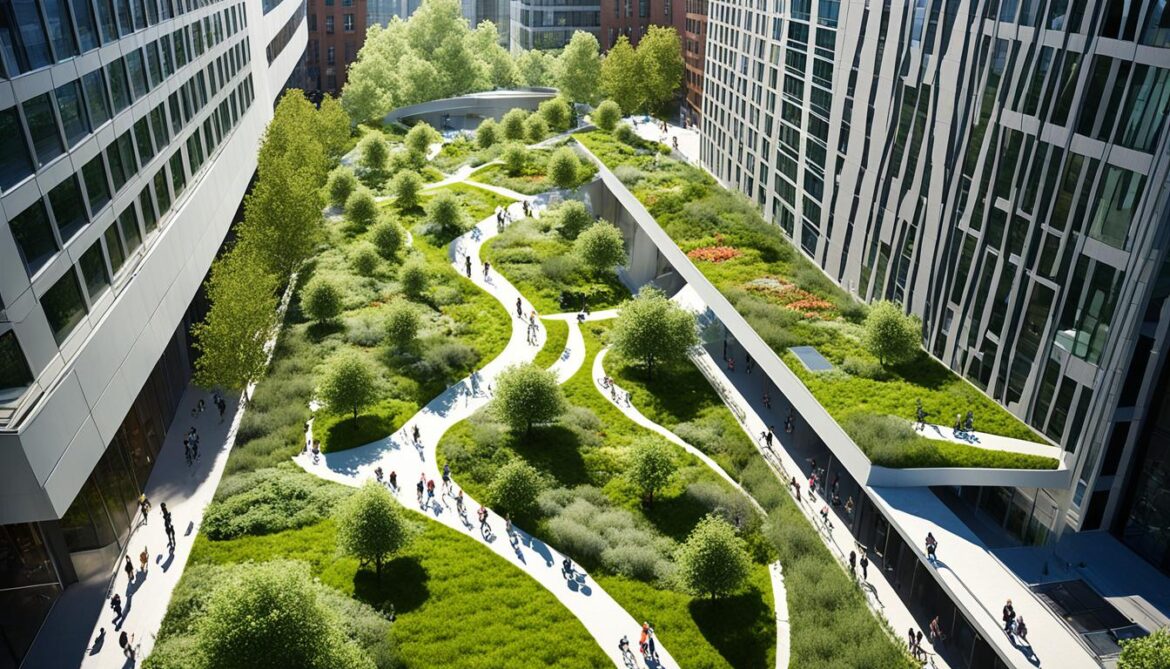
Building a sustainable future requires collective effort and collaboration between policymakers, architects, builders, and communities. By prioritizing environmental preservation and the implementation of green infrastructure, Kyrgyzstan aims to lead the way in sustainable development, demonstrating a commitment to a better and greener tomorrow.
The Role of the Ecological Construction Council
The Ecological Construction Council in Kyrgyzstan plays a crucial role in promoting environmentally friendly constructions. The council collaborates with architects, engineers, and developers to ensure that construction projects adhere to sustainable design principles and minimize environmental impact. Through their efforts, Kyrgyzstan aims to create a built environment that is both aesthetically pleasing and environmentally conscious.
Sustainable Design Principles
The Ecological Construction Council emphasizes the importance of incorporating sustainable design principles into construction projects. This includes using environmentally friendly materials, implementing energy-efficient systems, and considering the long-term environmental impact of buildings. By encouraging sustainable design practices, the council contributes to reducing the carbon footprint of the built environment in Kyrgyzstan.
Minimizing Environmental Impact
The council’s primary objective is to minimize the environmental impact of construction projects in Kyrgyzstan. By working closely with architects, engineers, and developers, they ensure that projects are designed and executed in a manner that preserves natural resources, reduces waste, and protects ecosystems. This focus on environmental stewardship helps to create a more sustainable and resilient built environment for future generations.
“The Ecological Construction Council plays a vital role in guiding the construction industry towards sustainable practices, ensuring a balance between development and environmental preservation.” – [Insert Name], Environmental Architect
Promoting Innovation
The council also promotes innovation in sustainable construction practices. They encourage the use of renewable energy sources, the integration of green technologies, and the adoption of eco-friendly construction methods. By fostering a culture of innovation, the council contributes to the growth and advancement of sustainable design in Kyrgyzstan.
Education and Awareness
Another important aspect of the Ecological Construction Council’s work is education and awareness. They organize seminars, workshops, and training programs to educate professionals and the public on sustainable construction practices. By raising awareness about the importance of environmentally conscious building, the council inspires more individuals to embrace sustainable design principles.
| Benefits of the Ecological Construction Council | Examples |
|---|---|
| Promotes sustainable design | Guidelines for architects |
| Reduces environmental impact | Evaluation of construction projects |
| Encourages innovation | Integration of renewable energy sources |
| Raises awareness | Public seminars and workshops |
By prioritizing sustainable design principles and minimizing environmental impact, the Ecological Construction Council plays a vital role in shaping the future of construction in Kyrgyzstan. Their collaborative efforts ensure that the built environment not only meets the needs of the present but also preserves the planet for future generations.
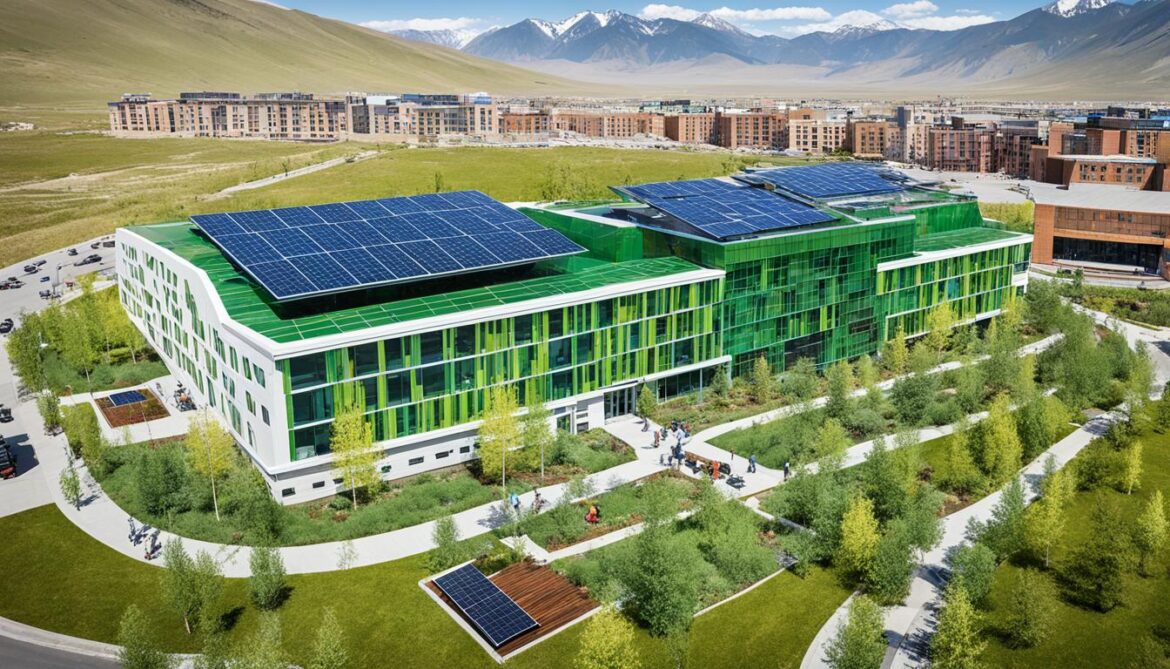
Environmental Concerns and Criticisms
The Asman eco-city project has faced environmental concerns and criticisms, with worries about potential harm to the ecosystem and the well-being of local communities. Environmental activists argue that the project may cause irreversible damage to the delicate balance of the ecosystem surrounding Lake Issyk-Kul. Experts have also raised concerns about the ecological situation at Issyk-Kul, including the impact of climate change and unregulated construction practices.
In particular, the construction practices employed in the project have come under scrutiny. It is feared that unregulated construction may lead to deforestation, pollution, and the displacement of wildlife, disrupting the natural habitat and balance of the ecosystem. Such actions stand in stark contrast to the project’s original goals of promoting sustainability and preserving the surrounding environment.
Moreover, the potential harm extends beyond ecological concerns. The well-being and livelihoods of local communities have also been questioned. Critics argue that the Asman eco-city project may lead to the displacement of indigenous people and disrupt their traditional way of life, further exacerbating social and economic inequality in the region.
It is essential to address these environmental concerns and criticisms to ensure that the Asman eco-city project aligns with its original vision of sustainability. This requires a thorough examination of construction practices, environmental impact assessments, and stakeholder participation in the project’s decision-making processes.
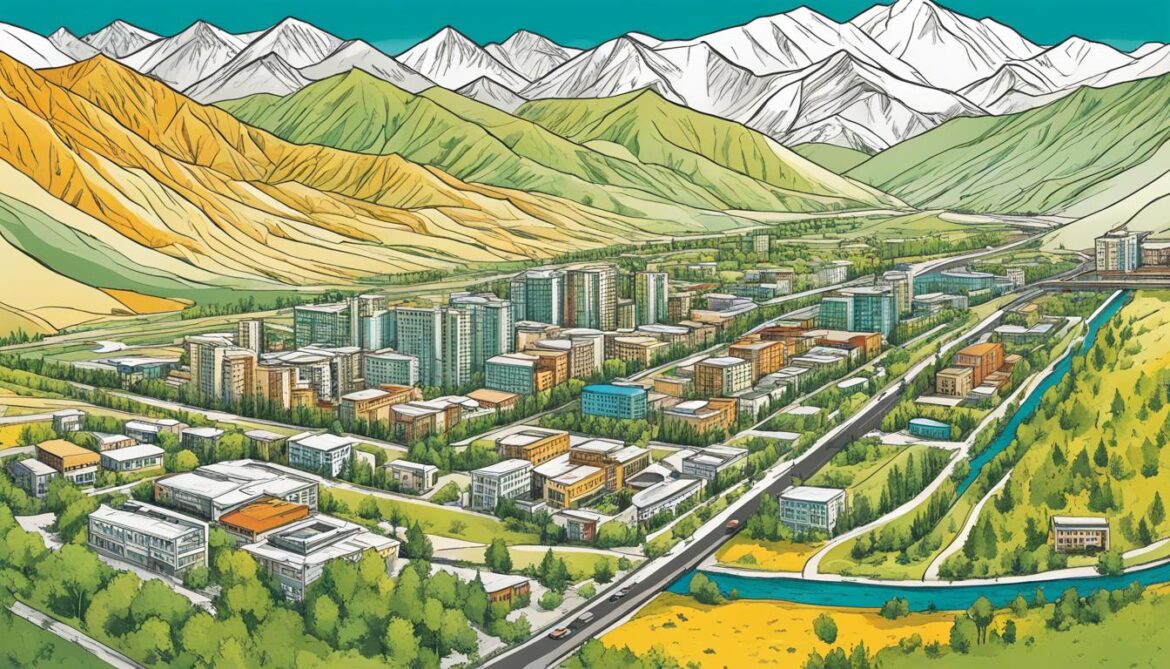
Building a Sustainable Future
The establishment of the Ecological Construction Council in Kyrgyzstan marks a significant milestone in addressing environmental concerns and promoting green buildings. With a focus on sustainable practices and environmental sustainability, the council plays a crucial role in ensuring that construction projects uphold eco-friendly standards.
Through the development and implementation of guidelines for green architecture, the council aims to create a more sustainable future for Kyrgyzstan. By setting standards that prioritize energy efficiency, waste minimization, and the use of environmentally friendly materials, they contribute to the preservation of natural resources and the reduction of carbon footprints.
One of the key aspects of building a sustainable future is community engagement. The council actively involves local communities in the decision-making process, giving them a voice and enabling them to contribute to the development of their built environment. This collaboration encourages shared responsibility and fosters a sense of ownership in creating a sustainable and environmentally conscious society.
Benefits of Community Engagement
Community engagement in sustainable architecture and construction projects has numerous advantages. It allows for:
- Enhanced social cohesion and a sense of community ownership.
- Increased awareness and understanding of sustainable practices.
- Opportunities for local job creation and economic development.
- Improved project outcomes through incorporating local knowledge and perspectives.
- Long-term behavioral change towards environmental stewardship.
By engaging communities in the sustainable development process, Kyrgyzstan can foster a collective commitment to environmental sustainability and create a lasting impact for future generations.
“Community engagement is not just about informing and consulting; it is about active participation, empowerment, and building partnerships. It is through collaboration and collective action that we can build a truly sustainable future.”
To illustrate the positive impact of community engagement, consider the following table documenting the benefits of involving local communities in sustainable construction projects:
| Benefits of Community Engagement |
|---|
| Enhanced social cohesion and sense of community ownership |
| Increased awareness and understanding of sustainable practices |
| Opportunities for local job creation and economic development |
| Improved project outcomes through incorporating local knowledge and perspectives |
| Long-term behavioral change towards environmental stewardship |
By working together and engaging with local communities, Kyrgyzstan can create a sustainable future that prioritizes environmental preservation, community well-being, and responsible development.
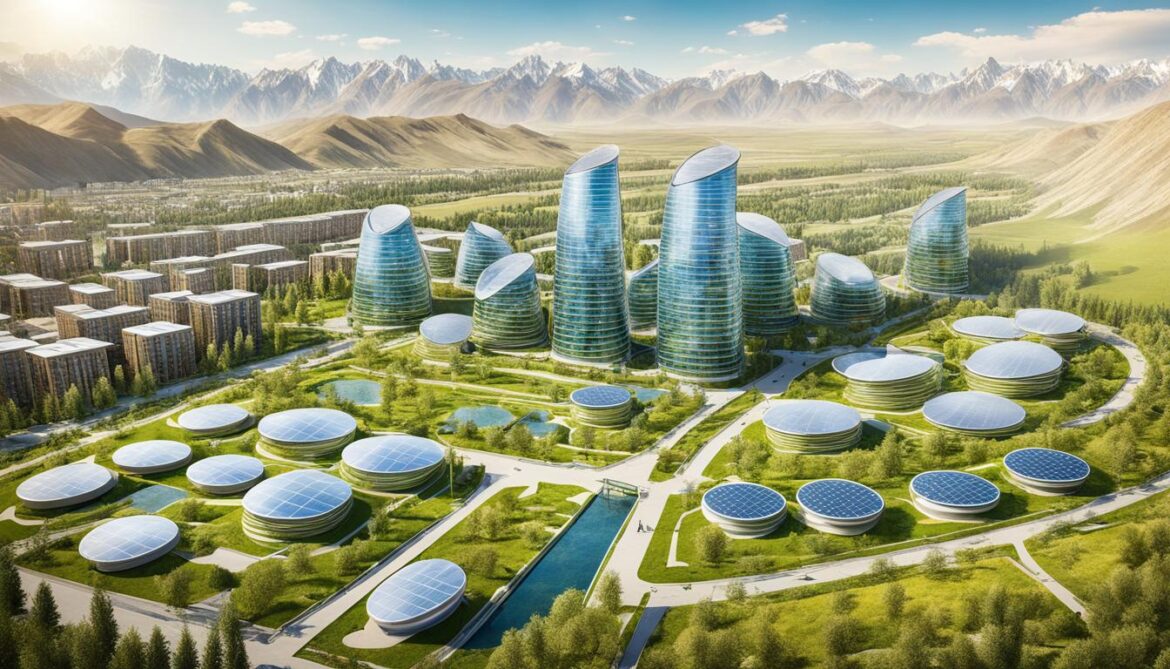
Conclusion
Kyrgyzstan’s commitment to sustainable architecture and eco-friendly constructions demonstrates its dedication to environmental conservation and sustainable development. By promoting initiatives like the Asman eco-city project and establishing the Ecological Construction Council, the country is taking significant steps towards creating a more sustainable future.
While there may be concerns and criticisms surrounding these projects, it is essential to address these issues and engage all stakeholders in the decision-making process. Through collaboration and open dialogue, Kyrgyzstan can overcome the challenges and ensure that the construction industry aligns with the principles of sustainable development and environmental conservation.
By integrating sustainable design principles, alternative energy sources, and green infrastructure into the built environment, Kyrgyzstan can minimize its ecological footprint and preserve its rich biodiversity. This commitment to sustainability paves the way for a greener and more sustainable Kyrgyzstan, where future generations can thrive in harmony with nature.




